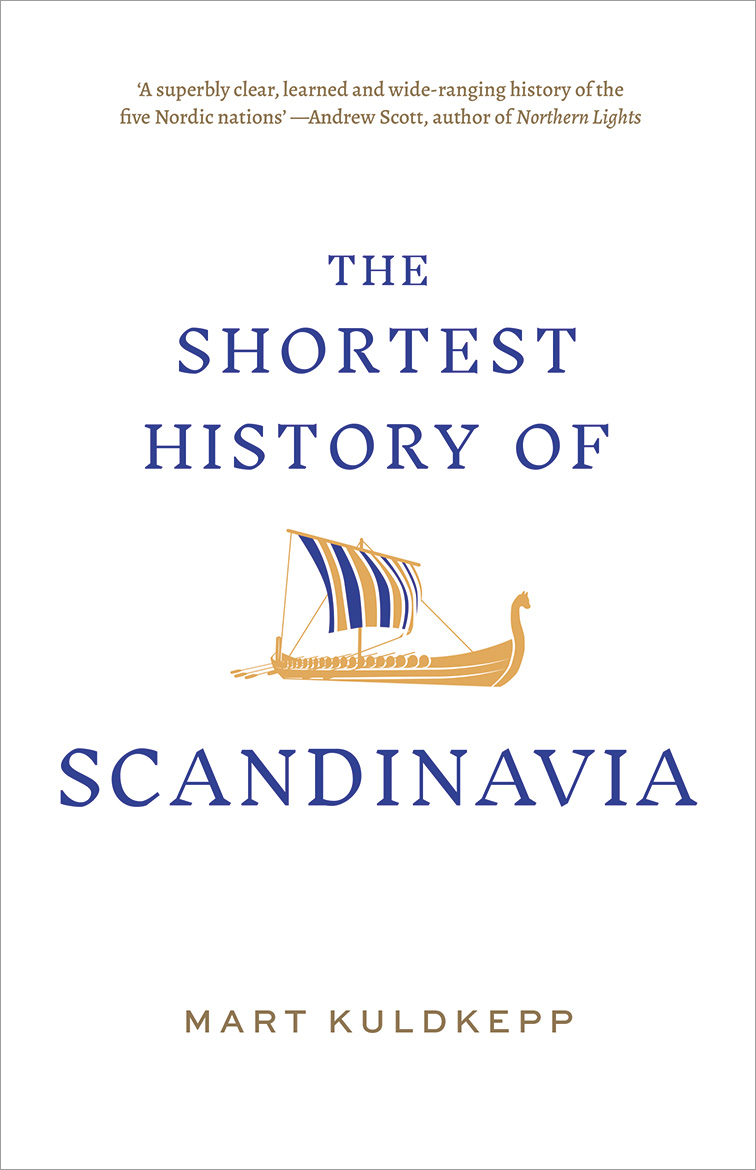
- Free Article: No
- Contents Category: Scandinavia
- Review Article: Yes
- Article Title: Cod wars
- Article Subtitle: The history that produced Nordicness
- Online Only: No
- Custom Highlight Text:
What can a reader expect from the ‘shortest’ history of anything? Probably something that gives basic information about that subject with a possible admixture of humour and a fresh approach that conceals the gaps that brevity inevitably produces. Mart Kuldkepp’s shortest history of Scandinavia achieves these goals skilfully and can be trusted to provide the general reader with a reliable narrative. It also succeeds in analysing what it is about the countries that we call Scandinavia that makes them special, creating a sense of ‘Nordicness’ that is recognised by both insiders and outsiders.
- Featured Image (400px * 250px):

- Alt Tag (Featured Image): Margaret Clunies Ross reviews ‘The Shortest History of Scandinavia’ by Mart Kuldkepp
- Book 1 Title: The Shortest History of Scandinavia
- Book 1 Biblio: Black Inc., $27.99 pb, 272 pp
- Book 1 Cover Small (400 x 600):

- Book 1 Cover (800 x 1200):

- Book 1 Readings Link: https://www.readings.com.au/product/9781760644963/the-shortest-history-of-scandinavia--mart-kuldkepp--2025--9781760644963#rac:jokjjzr6ly9m
Kuldkepp describes his approach as ‘partly chronological and partly thematic’. After first defining what he means by ‘Scandinavia’, which includes the less familiar communities of Iceland, the Faroe Islands, Greenland (yes, Mr Trump) and Finland, as well as Norway, Sweden and Denmark, he pursues the history of these communities from prehistory until the near present day. The Russian annexation of Crimea in 2014 and the ongoing conflict in Ukraine, with which he concludes his survey, have precipitated several significant changes in Scandinavian politics that he is unable to cover. However, his analysis of the political and economic changes within Scandinavia in the twentieth and early twenty-first centuries is extremely well done, especially its treatment of the commonly adopted Scandinavian position of political neutrality.
The author’s presentation of the intricacies of Scandinavian history from the Middle Ages to today is impressive, as is his ability to keep control of the sometimes-disparate fates of individual Nordic countries across the centuries, which includes Finland’s shifting alliances with Sweden and Russia, and Iceland’s loss of autonomy, first to Norway and then to Denmark. Such discussion will give the reader an insight into a history that is by no means straightforward.
The greatest strength of this book is its account of political history rather than Scandinavian culture more generally. Kuldkepp’s technique is to devote the main part of each chapter to a series of events that occurred in a contained chronological period; in many cases, this involves an account of conflict between the kingdoms of Denmark and Sweden, with changes outside the political arena addressed in a series of text boxes, referred to within the narrative, but not forming an integral part of it. The text boxes themselves are printed in grey-scale and a smaller font size, which I found unattractive and hard to read. Their content covered many important topics that could have been treated in much greater detail, had space allowed. A few random examples indicate the range of topics treated in this way: ‘King Harald Bluetooth and Bluetooth Technology’, ‘Scientific Achievements in the Seventeenth and Eighteenth Centuries’, and ‘The Cod Wars’.
Some of the topics treated, often amusingly, in the text boxes, deserve greater coverage, even in a ‘shortest’ history. These include the impact of the Reformation on the Scandinavian countries, the development of the ideology of the welfare state, and the causes and effects of the mass emigration of Scandinavian people out of Scandinavia during the nineteenth and early twentieth centuries. Although Kuldkepp often mentions such cultural changes in his general coverage of a historical period, their effects on society at large are presented rather mechanically. In Chapter Seven, ‘Wars and Politics: 1500s–1600s’, the Reformation that forced Scandinavian Catholics to adopt a form of Protestantism is treated as part of the political landscape, rather than a change that affected people’s ways of thinking and behaving.
Important Scandinavian artists, writers, and thinkers are largely confined to the text boxes, while associated cultural movements are mentioned briefly, sometimes obscurely, in the main narrative. One of the important intellectual movements of the late eighteenth and early nineteenth centuries, Romantic nationalism, is described briefly in Chapter Eleven, but how this movement was enriched by philosophers like Søren Kierkegaard, poets such as Adam Oehlenschläger, and the ‘multifaceted endeavours’ of the influential Danish writer N.F.S. Grundtvig is not clearly explained. Hans Christian Andersen, on the other hand, gets both a picture of his statue in Copenhagen and a whole text box to himself.
The book’s penultimate chapter, ‘Nordic Cultural Exports and “Scandimania”’, concludes on a feel-good note, reminding us of the Scandinavian cultural exports we enjoy, from Ikea furniture to Nordic noir crime fiction to the pop group Abba, not forgetting the extraordinary role of the Vikings and Norse mythology in the popular media.
The Shortest History of Scandinavia contains a select bibliography and an index and is illustrated with five maps and thirty black-and-white illustrations. Unfortunately, the quality of the images is rather disappointing; most are small and many are too dark or indistinct.


Comments powered by CComment